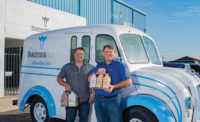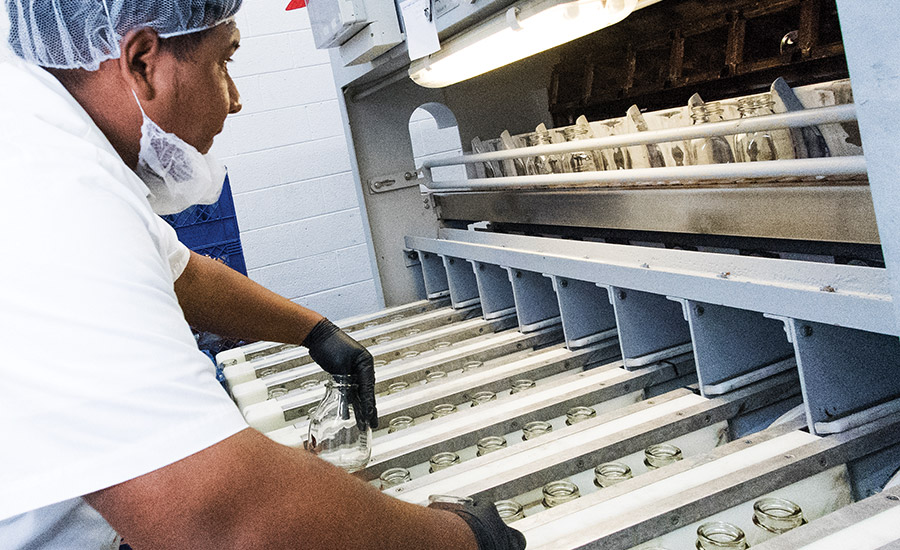Danzeisen Dairy takes an old-school approach to milk processing
Using vintage equipment and glass bottles, Danzeisen Dairy produces only the freshest-tasting milk and flavored milk for its Arizona neighbors

(l to r) Kevin Danzeisen, general manager, and Clayton Danzeisen, chief financial officer, show off some of the creamery’s high-quality products — all of which are packaged in glass.

Kevin Danzeisen, general manager, points to one of the creamery’s milk processing tanks.

Vintage equipment fills glass bottles with strawberry milk before capping them at the Danzeisen Dairy creamery.

After the flavored milk is filled and capped, the bottles are hand-packed into crates.

An old-fashioned bottle washer thoroughly cleans, rinses and sanitizes new and returned glass bottles

Crated bottles of milk go to the creamery’s cold storage area before they are loaded into trucks for distribution directly to retail and foodservice customers.






You won’t find any fancy-looking equipment at the creamery operated by Phoenix-based Danzeisen Dairy LLC. Tucked into a mixture of farm, industrial and residential properties in Phoenix’s Laveen neighborhood, the creamery relies on retrofitted vintage milk processing equipment — much of it from the 1940s, 1950s and 1960s, and all of it from U.S. manufacturers — to produce its craft dairy products.
“There’s some automation, but very little. There is new technology in some of the control systems, but a lot of it is manual labor — old-school milk processing,” said Lamar Schrock, the plant’s manager.
Schrock helped with the facility’s design, installation and setup when he was employed by a Maryland firm that specialized in designing and building small processing plants. He was a big part of the plant’s opening day on Nov. 1, 2014 — and then was lured back to oversee plant operations permanently in January 2016.
House of glass
In the 5,500-square-foot plant —a former Volvo equipment dealership — a dozen full-time employees process and package milk, flavored milk, half & half, cream and butter five days a week, in two overlapping day shifts. The first shift begins at 4 a.m.; the second, at 9 a.m. Production wraps up around 4 or 5 p.m., depending on when the day’s production orders are complete.
They start with fresh milk supplied by Danzeisen Dairy’s own Phoenix dairy farm, which is only about a mile away from the creamery. The milk is delivered by tanker truck each day at about 4:30 a.m., Schrock said. It is then transferred into stainless steel tanks; it undergoes separation and pasteurization soon after.
One of the creamery’s differentiators is its environmentally friendly choice of packaging. All milk, cream, half & half and egg nog products, from pint to half-gallon sizes, are bottled in refillable glass. And butter is packaged in glass jars. Except for the bottle caps and jar caps, the plant is a plastic-free zone.
“That’s what we know how to do,” explained Kevin Danzeisen, general manager of Danzeisen Dairy. “We know how to put milk in glass bottles. We know how to clean glass bottles. We know how to return glass bottles.”
The creamery also knows how to produce some pretty darn tasty products, including a variety of flavored 2% milks made with all-natural flavors and colors. During Dairy Foods’ visit, employees were mixing and bottling pint sizes of the strawberry flavor. Beet juice powder is used to give it an appealing pink hue, while strawberry preserves give it an authentic strawberry flavor.
Right now, all flavored milks are mixed using a funnel system. But a liquefier to blend the ingredients is on Danzeisen’s wish list.
“That’s probably the top piece of equipment that everybody wants,”
he noted.
Critical to milk-bottling operations is a vintage automatic bottle washer. Before returned glass bottles are reused, they get a soak and a wash, then are thoroughly rinsed and sanitized.
Employees currently load the bottle washer by hand. Equipment that could automatically load bottles into the bottle washer also ranks high on employees’ wish list, Danzeisen said.
The clean bottles travel through an old-style filler and capper. The bottled and capped pasteurized milk — which is also antibiotic- and hormone-free — then is manually packed into milk crates and transported to the creamery’s cooler space. The space was recently expanded via the addition of cargo shipping containers.
Unless they are destined for the creamery’s in-house retail store, finished products are loaded onto trucks — via seven loading docks the creamery added to the property. From there, they travel directly to Arizona retail and foodservice customers, Danzeisen said.
Focused on quality
Danzeisen Dairy takes a number of steps to ensure the finished products are of the highest possible quality.
“We have GMPs in place, protocols in place, that all employees are required to follow,” Schrock noted. “There’s training that’s done for all of the different processes. Everybody’s well-informed about what’s expected of them.”
Employees are cross-trained so they know how to perform multiple tasks, he added. That way, they can step in to replace someone who’s sick or on vacation — without compromising product quality or employee safety.
Throughout processing, the milk is kept at a constant cold temperature. Employees also pull a bottle from every line for taste-testing, Schrock said. Some additional product quality tests are conducted in an in-house lab, while other tests such as shelf-life studies are contracted out to a third party.
Cleanliness is critical to quality, too. Employees swab bottles regularly as they come off the line to make sure they’re clean, Danzeisen said. And the plant’s five-day-a-week processing schedule gives employees ample time to augment regular clean-in-place (CIP) procedures.
“We have time to do a really, really good job of taking things apart, making sure that all of the seals are good, making sure all of the CIP is done right,” he said. “That’s one thing that really helps our shelf life, I think.”
Environmental responsibility also is a creamery focus. In addition to bottling its milk in infinitely recyclable glass, the facility recycles all of its wastewater. Most of the water is trucked to Danzeisen Dairy’s dairy farm to aid in dust control, Schrock said. The wash water, meanwhile, gets recycled within the plant.
Up to the challenge
As a small craft dairy producer, Danzeisen Dairy does face a few challenges. One of them is a limited amount of capital.
“But it’s a good challenge to have — trying to produce more volume, more products with what you have,” Schrock said. “It’s not a bad thing. We always aim to try to get by with less.”
And being small offers advantages, too. One of them is flexibility in terms of production.
“We’re able to adapt quickly to changes,” Schrock said.
Another is the “family feel” of the business.
“We have a lot of employees who come to our business because they don’t want the ‘corporate feel’ in their workplace,” Schrock noted.
That said, labor is an issue at the plant, Danzeisen said. Although the creamery had zero turnover during its first two years of operation, its luck changed when growth required the addition of new employees in year three.
“And those new people who were coming in were turning over,” Danzeisen explained. “But we still have the main core people here.”
A related challenge is getting plant employees to show up for work on time. Like the dairy farm that supplies it, the creamery even offers a bonus to each employee who arrives on time every day during a pay period, Danzeisen noted.
“But most people don’t get it — it’s just the reality of the workplace anymore,” he said. “We’re trying to figure out how we can adapt, how we can motivate them.”
Despite the challenges, the creamery managed to keep up with what amounted to an outstanding growth wave in 2017. Danzeisen noted that sales grew by 300% in comparison to 2016.
“It’s new-store sales. Same-store sales are up, too, but it’s mostly from new customers.”
Looking for a reprint of this article?
From high-res PDFs to custom plaques, order your copy today!














